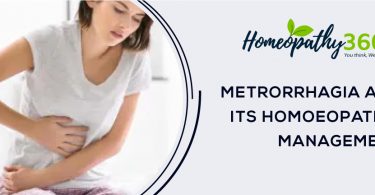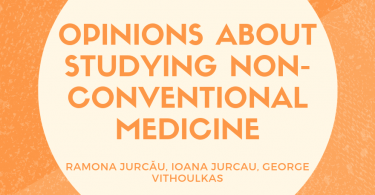
ABSTRACT:
Allergic rhinitis, also known as hay fever, is a chronic atopic inflammatory condition of the nasal mucosa and adjacent tissues caused by allergen exposure, which causes IgE-mediated inflammation .A 50-year-old man with allergic rhinitis was successfully treated with a single dose of individualized homoeopathic medicine, pulsatilla 200. Assessing Absolute eosinophilic count (AEC) and Immunoglobulin E (IgE) levels reveals an improvement.
KEYWORDS:
Allergic rhinitis, AEC, IgE, pulsatilla.
INTRODUCTION:
Allergic rhinitis (AR) is an inflammatory condition of the nasal mucosa caused by allergens found indoors or outdoors.1 Immunoglobulin E activates mast cells or basophils in the nasal mucosa, leading in the release of vasoactive mediators such as histamine, which causes inflammation. AR symptoms include nasal congestion, rhinorrhoea, itching, and sneezing, as well as ocular symptoms such as irritation, redness, and tearing.2
Allergic rhinitis is one of the most frequent chronic illnesses in high-income countries, with certain countries having a frequency of up to 50%.3 The WHO estimates that the global burden of allergic rhinitis is 400 million people.4 Atopy affects around 40% of the world’s population, and allergic rhinitis is the most frequent manifestation of atopic tendency.According to an All India Co-ordinated Project on Aeroallergens and Human Health survey conducted in New Delhi in 2000, 20-30% of the population suffers from allergic rhinitis, and 15% develop asthma.5
According to Allergic rhinitis and its impact on asthma (ARIA) 2008 (revised in 2016) in collaboration with WHO, if patient is suffering from two or more symptoms out of the following lasting for at least one hour per day for four days or more per week and also for four or more weeks in past 12 months. 6
– Watery anterior rhinorrhoea
– sneezing especially paroxysmal
– Nasal obstruction
– Nasal pruritis
– +/- conjunctivitis
Antihistamines, intranasal or sublingual allergen-specific immunotherapy, and similar therapies are recommended in adults and children with AR, with or without concurrent asthma, according to the 2010 Allergic Rhinitis and its Impact on Asthma (ARIA) Guidelines. Antihistamines can pass the blood-brain barrier and impair working memory and vigilance, resulting in drowsiness. Sublingual immunotherapeutic drugs frequently generate local adverse effects (about 30% of the time). Complementary and alternative medicines (CAM) are, however, widely employed in the treatment of AR.
It is critical to improve the patient’s quality of life because it has an impact not only on his or her health but also on the social aspects of his or her existence. Rhinitis has an impact on one’s quality of life, performance, and attendance at school and work. It has a substantial impact on healthcare costs. The use of homoeopathic medications will not only treat the sick but will also improve the quality of life that has been harmed by the illness. 7
Homoeopathy treats each condition on a unique basis. The individualized totality was formed by taking into account the mental generals, physical generals, and characteristic particulars. The purpose of this study is to examine the management of allergic rhinitis with individualised homoeopathic medicine by assessing IgE and AEC levels
CASE REPORT:
A case of 50-year-old male patient presented to the outpatient department of Father Muller Homoeopathic Medical College and Hospital Mangalore on 11/02/2021 with a complaint of continous sneezing due to dust exposure for the past two years.
The patient gradually experienced sneezing (paroxysm: 8-10) as well as nasal discharge and eye watering.The nasal discharge is normally fluid and heavy, but it turns yellowish in cold weather conditions. He also complained about itching in his eyes and nose. The severity of the problems eventually increased.Sneezing is more common in cold weather, such as winter and rainy season, as well as when exposed to dust and in the evening. There will also be alternate nasal block in the evening. Warm weather alleviates all of the symptoms.
PAST HISTORY:
Medical history: chickenpox in childhood
Treatment history: nothing significant
Allergic history: allergic to dust
Family history: mother and sister allergic to dust
PATIENT AS A PERSON:
Diet: mixed
Appetite: good
Thirst: thirstless (1l/day) warm water
Desire: spicy+++,fried items
Aversion: nil
Bowel: regular 1/day
Bladder: regular 5/day
Perspiration: generalized
Sleep: refreshed (11pm-7am)
Dreams: unremembered
Thermal state: hot patient
LIFE SPACE INVESTIGATIONS:
Mentals:
Yielding Disposition: In work area and personal relationship he doesn’t oppose others opinion even if he doesn’t like it and obeys it. When asked why he doesn’t oppose others because of the consequences. One of the example: he wanted to take arts in PUC but because of his parents he pursued science even though he was not interested.
Ailments from lack of love / abandonment feeling: he has retired from work 2 years back after which he is feeling lack of love from his wife. He says she is not giving enough time.
GENERAL PHYSICAL EXAMINATIONS:
Moderately built and nourished
Well oriented with time, place and person.
No signs of pallor, cyanosis, clubbing, icterus, jaundice, oedema
Vitals:
Temperature: afebrile at the time of examination
Pulse rate: 80 beats/min
B.P.: 140/100mmhg
RR: 18breaths/min
Weight: 65kg
Systemic examinations:
Respiratory system:
Nose: b/l turbinates’ enlarged
Paranasal Sinus: not tender
Normal vesicular breath sounds heard, no added sounds.
CVS: S1 S2 heard, no murmurs
GIT: NAD
ANAYSIS AND EVALUATION OF SYMPTOMS: table 1
| MENTAL GENERALS | PHYSCIAL GENERALS | CHARACTERISTIC PARTICULAR |
| Ailments from lack of love Yielding disposition | Craving : spicy and fried food Hot patient | Continous sneezing <evening Thick clear nasal discharge with alternating nose block <evening <dust exposure <cold weather in |
Table 1- evaluation of symptoms
RUBRICS SELECTED:
- Mind – ailments from neglected ;being
- Mind – yielding disposition
- Stomach thirstless
- Generals-food and drinks -pungent desire
- Generals food and drinks – fried food – desire
- Nose- discharge -clear
- Nose discharge thick
- Nose-obstruction -alternation sides
- Nose – obstruction-evening
- Nose sneezing -evening
- Generals -cold air-agg.
REPERTORIAL SHEET : (Image 1)
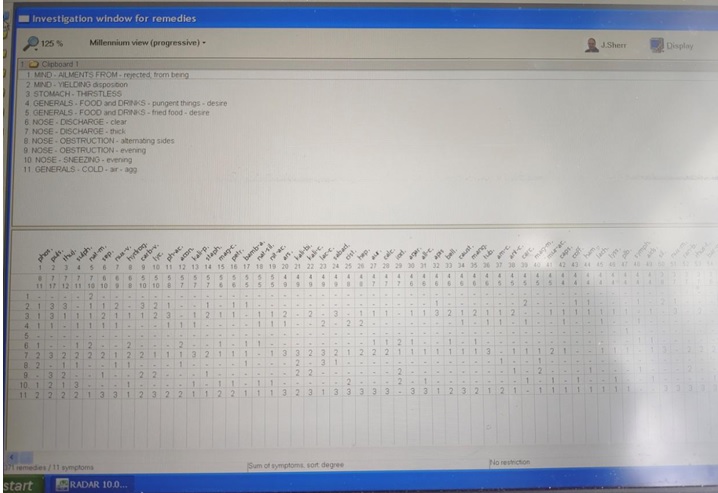
PRESCRIPTION:
11/2/2021
Rx
- Pulsatilla200 1P
- PL 4-4-4 *2 weeks
FOLLOW UP: (Table 2)
| c/o sneezing slightly better (4-5) paroxysms c/o coryza same c/o noseblock same generals good | 24/2/2021 Rx 1.Puls plain 1P 2.PL 4-4-4 *2 weeks |
| C/o sneezing slightly better only on exposure to dust otherwise not present c/o coryza slightly better c/o noseblock slightly better | 10/3/2021 RX 1.Puls plain 1P 2.PL 4-4-4 *2 weeks |
| C/o sneezing better c/o coryza better c/o noseblock better | 08/04/2021 Rx 1.Puls plain1P 2.PL 4-4-4 *2 weeks |
Table 2: follow up
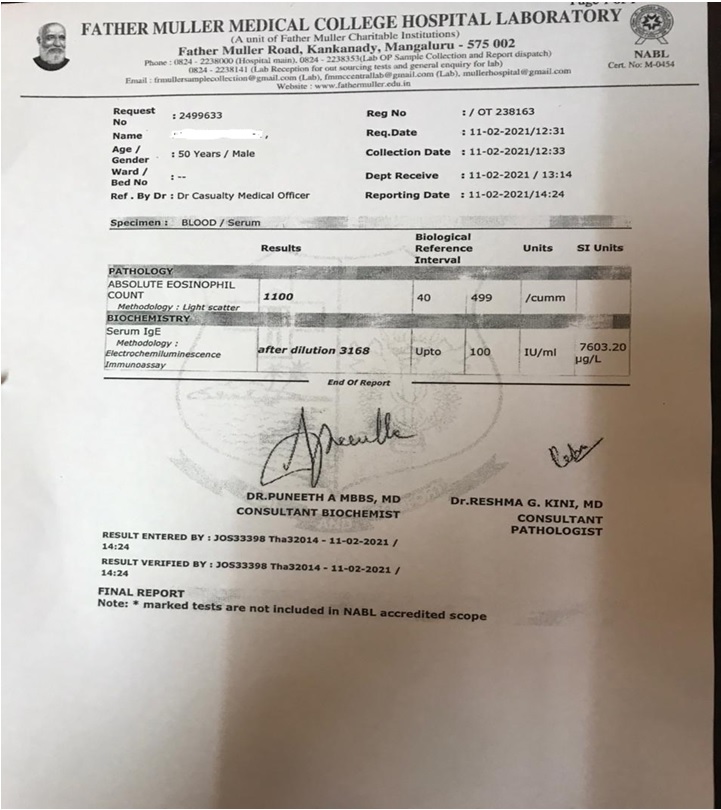
IMAGE -2
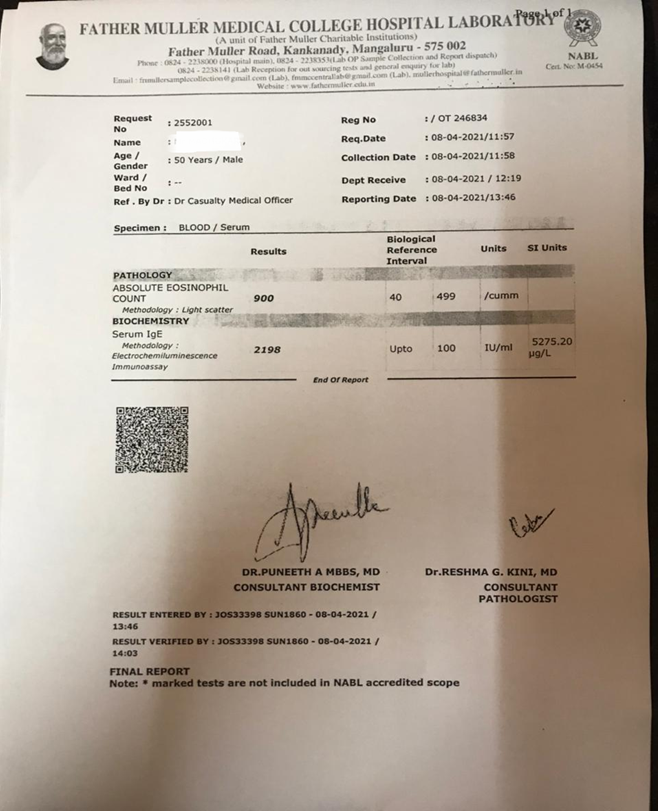
DISCUSSION:
In India, approximately 20-30% of the population suffers from allergic rhinitis, with the frequency growing. There are numerous homoeopathic specific medicines for allergic rhinitis. However, these only provide temporary alleviation unless the patient is treated with individualized homoeopathic medication. The case was taken in detail, after which the symptoms were evaluated considering the mental generals, physical generals and characteristic particulars of the case. The case was repertorised using synthesis repertory. After repertorising the case, pulsatilla was given as a individualized constititional homoeopathic remedy after referring back to materia medica. The case was evaluated based on IgE and AEC before and after the study along with symptomatic relief of the patient .IgE levels reduced from 3168IU/ml to 2198IU/ml , AEC from 1100/cumm to 900/cumm(image-1 and image-3) and the patient is symptomatically feeling better in the period of 2 months .
CONCLUSION: Pulsatilla was administered in a single dose without repetition in this case. With evidence, this case concludes the efficacy of a constitutional homoeopathic cure in the treatment of allergic rhinitis. Because there is just one case report, research must be done using evidence-based reporting
CONFLICT OF INTEREST: None
FINANCIAL SUPPORT: None
DECLARATION OF PATIENT CONSENT: subject has given consent for the image of the reported in the article.
REFERENCE:
- Roxbury CR, Qiu M, Shargorodsky J, Lin SY. Association between allergic rhinitis and poor sleep parameters in U.S. adults. International Forum of Allergy & Rhinology. 2018;8(10):1098–106. doi:10.1002/alr.22174
Available from:https://pubmed.ncbi.nlm.nih.gov/29979840/
- Almehizia AA, AlEssa RK, Alwusaidi KM, Alzamil KA, AlJumah M, Aljohani S, et al. Allergic rhinitis: Disease characteristics and coping measures in Saudi Arabia. PLOS ONE. 2019;14(6). doi:10.1371/journal.pone.0217182 Available from: https://doi.org/10.1371/journal.pone.0217182
- Bousquet J, Anto JM, Bachert C, Baiardini I, Bosnic-Anticevich S, Walter Canonica G, et al. Allergic rhinitis. Nature Reviews Disease Primers. 2020;6(1). doi:10.1038/s41572-020-00227-0 Availble from: https://pubmed.ncbi.nlm.nih.gov/33273461/
- Cruz AA. Global surveillance, prevention and control of chronic respiratorydiseases: a comprehensive approach. World Health Organization; 2007.
- K V G, Chandrashekar P, P L B. A cross sectional study of bronchial asthma in allergic rhinitis patients : A community based assess ments among adults in Bangalore. Journal of Evolution of Medical and Dental Sciences. 2015;4(101):16596–8. doi:10.14260/jemds/2015/2474 available from: http://dx.doi.org/10.14260/jemds/2015/2474
- Brożek J, Bousquet J, Agache I, Agarwal A, Bachert C, Bosnic-Anticevich S et al. Allergic Rhinitis and its Impact on Asthma (ARIA) guidelines—2016 revision. Journal of Allergy and Clinical Immunology. 2017;140(4):950- 958.\ available from https://doi.org/10.1016/j.jaci.2017.03.050
- Banerjee K, Mathie RT, Costelloe C, Howick J. Homeopathy for allergic rhinitis: a systematic review. The Journal of Alternative and Complementary Medicine. 2017 Jun 1;23(6):426-44. available from : https://doi.org/10.1089/acm.2016.0310
- Bagdi N, Ram H, Choudhary P, Singh A, Sharma P, Aggarwal T. Allergic rhinitis treated with lesser known homoeopathic medicine, Cassia sophera: a case report. Homeopath Her. 2020:24-8. available from : https://www.researchgate.net/publication/338739254_Allergic_rhinitis_treated_with_lesser_known_homoeopathic_medicine_Cassia_sophera_a_case_report
By ,
Dr Ashwitha
MD Part-1
Department of Organon of medicine and philosophy
Govt. Homoepathic medical college and hospital
Bnagalore-79
UGO,
Dr shobha B Malipatil
Professor Department of Organon of medicine and philosophy
Govt. Homoeopathic medical college and hospital
Bagalore-79



